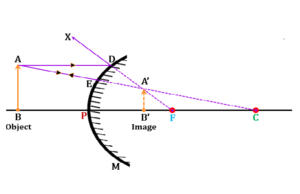Table of Contents
Introduction
In a convex mirror, image creation is primarily determined by two factors. It primarily concerns the location of an item in a convex mirror, whether it is at infinity or between infinity and the mirror’s pole. However, before we delve deeper into the image generation in a convex mirror, we must first grasp a few key concepts.
Convex Mirror
A convex mirror is a sort of spherical mirror in which the reflecting surface is the bulged out section of the sphere, bulging out towards the incoming light source in this type of mirror. Because incident light is reflected outwards (diverged) due to its form, they are also known as diverging mirrors and are not utilized for focusing light.
Both of the principles of reflection apply to every point in the mirror. In this situation, the normal is drawn normal to the tangent at the point of incidence, that is, it is drawn by connecting the mirror’s centre of curvature to the point of incidence. Because the normal to the surface varies at each location on the mirror, the rays diverge after reflection.
Some Important Terms
1. Pole: The centre of a spherical mirror’s reflecting surface. It is commonly indicated by the letter P and is found on the mirror’s surface.
2. Centre of curvature: The centre of curvature refers to the sphere generated by the reflecting section of a spherical mirror. C is the most common abbreviation for it. This is not a part of the mirror and is located outside of the mirror’s reflecting surface. It is located behind the mirror in the case of a convex mirror.
3. Curvature radius: This is the radius of the sphere generated by the reflecting portion of the sphere. R is the character that represents it.
4. Principal axis: This is the straight line that passes through the pole and the spherical mirror’s centre of curvature. This is common for the mirror at the top of the pole.
5. Principal focus: After reflection, incoming rays that are parallel to the principal axis appear to diverge from a common point on the primary axis, which is known as the principal focus of a convex mirror. It’s commonly symbolized with the letter F.
6. Focal length: This is the distance between the pole and the mirror’s primary focus. It is represented by the letter f.
Convex Mirror Image Formation
We suppose that the rays are paraxial during image generation, meaning that they are incident at positions near to the mirror’s pole P and make tiny angles with the primary axis. We discuss two placements of the item before the convex mirror for a convex mirror.
When an item is positioned at infinity, it is said to be infinite.
When the item is positioned between infinity and the mirror’s pole.
We consider two rays parallel to the primary axis and one directed towards the pole of the mirror emanating from the object for image generation by a convex mirror under this circumstance. After reflection, these rays generate an image at F, the mirror’s primary focus, which is behind the convex mirror. The resulting picture is massively diminished, virtual, and erect.
FAQs
In a convex mirror, how does an image form?
Virtual pictures are always formed by convex mirrors. This is due to the fact that the convex mirror's focus point and center of curvature are both hypothetical positions that cannot be reached. As a result, the picture is created within the mirror and cannot be projected onto a screen.
Which sort of picture does a convex mirror produce?
When an item is positioned in front of F, virtual pictures are always generated by convex mirrors, and when the object is placed behind F, virtual images are formed by concave mirrors.
In a convex mirror, what is the nature of the image?
A convex mirror's image is always upright (straight), virtual, and smaller in size.






